- Home
- About Artist
- Watercolor Supplies
Tried and True Watercolor Art Supplies
These watercolor art supplies work for me. They will work for you, too.
You may be wondering, what's the best watercolor paint? What are the best brushes for watercolor?
What paper do we use for watercolor? What is Aquabord? Can we paint on canvas?
All the answers are below with a supply checklist at the end of the page.
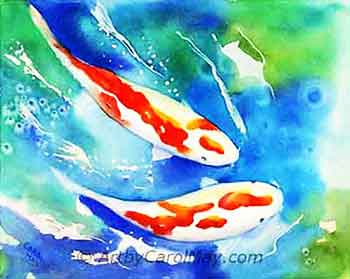 Aquabord is great for watercolors.
Aquabord is great for watercolors.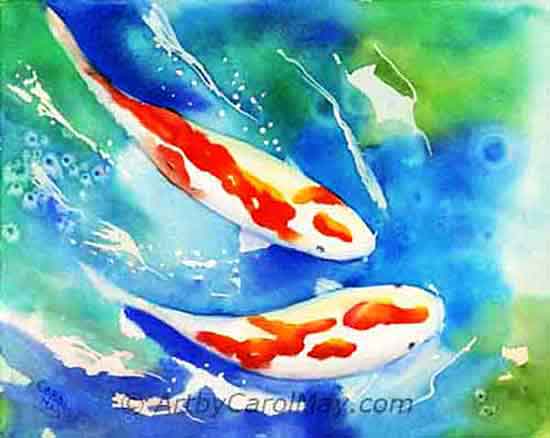 Aquabord is great for watercolors.
Aquabord is great for watercolors.What Is the Best Watercolor Paint?
There are numerous watercolor paint companies, but I use Winsor & Newton paints almost exclusively.
Winsor & Newton paint is a very reputable English company that has been the standard of quality paints since the 1800s. They offer artists the widest and most balanced choice of pigments with the greatest possible permanence.
The purity, brilliance and transparency of color is not met by any other watercolors. Since 1832 when Winsor & Newton introduced the first moist watercolors to the world, much of their reputation for quality came from their professional watercolors.
Tube Watercolors
Tube watercolors are semi-liquid packaged in tubes.
Use them by adding a little water for painting. Add a lot more water and you can paint washes on large areas. They are good for both small and large paintings.
Tube watercolors make it easy to get bright juicy colors in your paintings.
Pan Watercolors
Pan watercolors are dried into small cubes.
They require a lot of water to reactive the color for painting. Adding all the water dilutes the color. They are handy for travel, painting outdoors and other small paintings.
As an affiliate I earn from Amazon sales with no extra cost to you. Learn More
Artist Quality Watercolor Paints
Artist quality paints have more concentrated, intense color. They contain more color pigments, so they cost more to produce. This is a high-grade watercolor paint used by the British Royal family.
Because they contain more color pigments, they will produce more paintings from one container compared to student paints.
Winsor & Newton Professional Watercolor Paint Set, sketchers' box, 5ml tubes of 12 colors
Winsor & Newton Professional Watercolor Paint Set, field box, 12 colors in half pans
This pocket-sized lightweight box is ideal for the outdoor artist with useful mixing surfaces, an additional sliding palette and a Series 16 sable brush.
Student Watercolor Paints
Student watercolor paints contain less pigment. They are less expensive and they are a great way to start painting and hold down the cost.
Winsor & Newton 'Cotman' paints contain the most pigment of all student paints. They are formulated for high transparency and provide outstanding light-fastness.
Winsor & Newton Cotman Watercolor Tube Set 5ml tubes of 10 Colors
Winsor & Newton Cotman Watercolor Half Pan Field Set a brush and mixing palette, 14 colors
What Can We Paint Watercolor On?
Watercolor paintings are traditionally done on watercolor paper.
There are more choices for watercolor art supplies. We can use canvas or hard-boards made specifically for watercolors.
What Paper Do We Use for Watercolors?
Watercolor papers come in Hot Press, Cold Press and Rough Press.
Cold Press watercolor paper is what most water-colorists use. Its texture pulls the paint off the brush onto the paper. Paint slides around on hot press paper. Rough press paper doesn't let the paint move very well.
Watercolor paper comes in 90, 140 or 300 pound weights. That is the weight of 500 sheets of paper. It is also sold in 22x30" sheets, tablets or rolls.
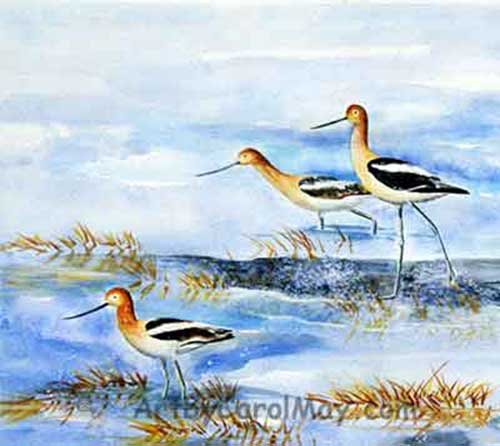 Watercolor on Arches paper
Watercolor on Arches paperThere are many good brands of watercolor paper. Arches 100% cotton watercolor paper is the top of the line and considered the very best.
140# paper is the most common. It must have its edges fastened down (stretched) to prevent warping when we paint.
Arches Watercolor Pad 140# cold press pad 10x14" 100% Cotton Paper - 12 sheets
Budget watercolor paper: Canson 140# watercolor pads 9x12" - 30 sheets
Watercolor paper in blocks have the edges fastened together to keep it from warping. The 300# watercolor paper is thicker and it will stay flat when we paint on it.
Arches Watercolor Block 300# cold press block 9x12" 100% cotton paper - 10 sheets
Watercolor paintings on paper must be matted and framed under glass to protect the painting.
What is Aquabord?
Aquabord is my favorite watercolor support. Why do I paint on Aquabord?
Ampersand's Claybord and Aquabord are excellent archival supports for modern watercolor painting. These hardboards are covered with pH neutral kaolin clay.
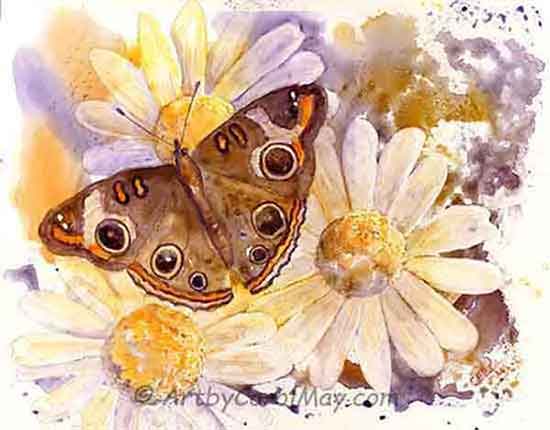 Buckeye Butterfly painting on Claybord
Buckeye Butterfly painting on ClaybordClaybord is smooth like hot press watercolor paper. Aquabord has a texture similar to cold press paper.
The dried watercolor paintings are sprayed with UV resistant Krylon spray. The painting may be framed without glass.
Oh, the beauty and ease of modern watercolor art supplies!
Can We Paint Watercolor on Canvas?
Another surface for watercolor painting is the modern watercolor canvas. Double check and make sure the canvas is labeled for watercolors.
- Before painting, wet the canvas with plenty of water with a large brush to break the surface tension of the canvas.
- Let the extra water evaporate before painting.
- The dried canvas watercolor painting needs to be sprayed with a fixative to protect the paint. Use the same Krylon UV resistant spray used on Aquabord and Claybord paintings.
- Canvas watercolor paintings are framed without glass and they are so light-weight.
Modern technology is wonderful. It has given us such a great variety of watercolor art supplies!
What Are the Best Brushes for Watercolor?
Watercolor brushes are soft. They are made of natural hairs such as sable or synthetic fibers or a mixture of the two.
The watercolor brush we use for painting is largely a matter of
personal preference. The favorite brush of one artist may be considered
useless by another.
How Many Brushes Do We Need?
It's amazing what we can paint with just one brush.
When I started painting watercolors someone gave me a couple of Loew-Cornell angular shaders a 1/2" and 3/4".
The tip of the angle was good for fine details and the flat side
covered more area.
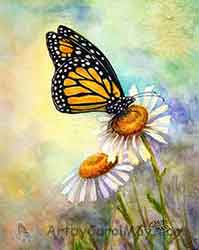
That
is all I painted with for about the first year of learning to paint watercolor.
The butterfly and hummingbird were painted with the 1/2" angle brush.
Then the 3/4" brush did the backgrounds.
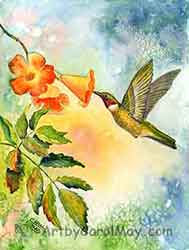
After painting with angular brushes for a while, I purchased expensive sable watercolor brushes. Sable brushes are an excellent investment for a serious artist.
The last couple of years, I have been using synthetic brushes that hold their point very well.
What Is a Good Quality Brush on a Budget?
A good quality synthetic brush will work just fine and significantly hold down the cost of watercolor art supplies. Every artist has their own favorites.
Many artists paint almost exclusively with round brushes. We can paint almost anything from details to washes with a good round brush.
Silver Brush - Black Velvet Round Brush for Watercolor, size 8
If you want more sizes, there is a pack of 3 brushes.
Silver Brush - Black Velvet Round Brushes Watercolor Brush Set, sizes 4, 8, and 12
Other watercolor artists do their paintings with flat brushes. Flats are good for painting buildings and other straight lines. We can also use the corner of flats for details.
Silver Brush - Black Velvet Square Wash Watercolor Brush, 1/2"
There is no need to spend a lot of money on watercolor art supplies to start. Get some painting experience and see what you like the best.
Your Watercolor Art Supplies Checklist
- Your choice of watercolor paint
- Something to paint on - paper, canvas or Aquabord
- A good brush
- A covered palette to keep your paints fresh
- Drawing materials and graphite transfer paper
- A water container and paper towels for clean-up
- Optional - Masking Fluid
These are the watercolor art supplies I have used over the years.
I have always lived in small-town areas where they don't have art supply stores. So for years my art materials were shipped from catalogues.


